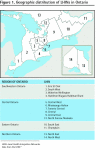Nipissing District Developmental Screen: patterns of use by physicians in Ontario
- PMID: 20154233
- PMCID: PMC2821255
Nipissing District Developmental Screen: patterns of use by physicians in Ontario
Abstract
Objective: To determine if providing the Nipissing District Developmental Screen (NDDS) free of charge is associated with increased use of this measure and to investigate regional variations in the use of the NDDS in Ontario.
Design: Retrospective analysis of purchasing data from before the NDDS was available at no cost compared with analysis of the results of a brief questionnaire completed by those downloading the NDDS for free.
Setting: Ontario.
Participants: Users of the NDDS.
Intervention: Provision of free on-line access to the NDDS.
Main outcome measures: Patterns of purchasing or downloading of the NDDS by FPs and health care professionals (HCPs) before and after implementation of the program.
Results: Before the program, 91 FPs (0.9% of FPs in Ontario) purchased the NDDS, and an additional 129 FPs (1.3% of FPs in Ontario) downloaded the NDDS in the year after the start of the program. Including all other HCPs increased the estimated number of users to 504 (representing an estimated 5.0% of all FPs in Ontario). Adjusting for group practice increased the estimate to 16.5% of all FPs in Ontario who had access to the NDDS. There were no significant differences in NDDS usage by FPs between central, southwestern, and northern Ontario (P > .05). Significantly fewer FPs in eastern Ontario accessed the NDDS than FPs in other areas of the province did (P < .001).
Conclusion: Despite measures to increase usage, only a small number of FPs access the NDDS in Ontario. However, free access to the NDDS does seem to contribute to removing barriers to screening, as indicated by a 3-fold increase in the number of FPs accessing the NDDS. Further research is required to investigate the reasons for these trends so that effective methods to increase the use of developmental screening measures in clinical practice can be implemented.
OBJECTIF: Déterminer si le fait d’offrir gratuitement le Nipissing District Developmental Screen (NDDS) entraîne une augmentation de l’utilisation de cet outil de mesure et examiner les variations régionales de l’utilisation de cet outil en Ontario.
TYPE D’ÉTUDE: Analyse des données sur l’achat du NDDS avant qu’il soit offert gratuitement, par rapport à l’analyse des résultats d’un court questionnaire auprès de ceux qui l’ont téléchargé gratuitement.
CONTEXTE: L ’Ontario.
PARTICIPANTS: Les utilisateurs du NDDS.
INTERVENTIONS: Le fait de rendre le NDDS accessible en ligne sans frais.
PRINCIPAUX PARAMÈTRES ÉTUDIÉS: Modes d’achat ou de téléchargement du NDDS par des MF et des professionnels de la santé (PS), avant et après l’instauration du programme.
RÉSULTATS: A vant le programme, 91 MF (0,9 % des MF ontariens) ont acheté le NDDS et 129 autres MF (1,3 % des MF ontariens) l’ont téléchargé durant l’année suivant le début du programme. L’inclusion de tous les autres PS faisait grimper le nombre d’utilisateurs à 504 (ce qui correspond en gros à 5 % de tous les MF ontariens). Cette estimation s’élèvait à 16,5 % de l’ensemble des MF ontariens ayant accès au NDDS si l’on tient compte d’une utilisation partagée dans les polycliniques. Il n’y avait pas de différence significative entre les régions du centre, du sud-ouest ou du nord de l’Ontario en termes d’utilisation du NDDS par les MF (P > ,05). Par rapport à ceux des autres régions de la province, un nombre significativement plus faible de MF de l’est l’Ontario ont eu accès au NDDS (P > ,001).
CONCLUSION: Malgré des mesures pour promouvoir l’utilisation du NDDS, seuls un petit nombre de MF ontariens l’utilisent. L’accès gratuit au NDDS semble toutefois contribuer à faire disparaître certains obstacles au dépistage, tel qu’indiqué par le triplement du nombre de MF ayant eu accès au NDDS. Il faudra d’autres études pour comprendre les raisons de ces tendances afin de pouvoir mettre en place des mesures efficaces pour accroître l’utilisation du dépistage des troubles de la croissance en pratique clinique.
Figures
Similar articles
-
Geographic variation in FP and GP scope of practice in Ontario: Comparative provincial study.Can Fam Physician. 2018 Jun;64(6):e274-e282. Can Fam Physician. 2018. PMID: 29898948 Free PMC article.
-
Evaluation of the revised Nipissing District Developmental Screening (NDDS) tool for use in general population samples of infants and children.BMC Pediatr. 2016 Mar 16;16:42. doi: 10.1186/s12887-016-0577-y. BMC Pediatr. 2016. PMID: 26983782 Free PMC article.
-
Referring patients with chronic noncancer pain to pain clinics: survey of Ontario family physicians.Can Fam Physician. 2011 Mar;57(3):e106-12. Can Fam Physician. 2011. PMID: 21402954 Free PMC article.
-
Community resources for psychiatric and psychosocial problems. Family physicians' referral patterns in urban Ontario.Can Fam Physician. 1995 Aug;41:1325-35. Can Fam Physician. 1995. PMID: 7580381 Free PMC article.
-
Developmental Delay: When and How to Screen.Am Fam Physician. 2017 Jul 1;96(1):36-43. Am Fam Physician. 2017. PMID: 28671370 Review.
Cited by
-
Screening school-age children for developmental language disorder in primary care.Int J Speech Lang Pathol. 2020 Apr;22(2):152-162. doi: 10.1080/17549507.2019.1632931. Epub 2019 Jul 1. Int J Speech Lang Pathol. 2020. PMID: 31262202 Free PMC article.
-
The Phenotypic variability of 16p11.2 distal BP2-BP3 deletion in a transgenerational family and in neurodevelopmentally ascertained samples.J Med Genet. 2023 Nov 27;60(12):1153-1160. doi: 10.1136/jmg-2022-108818. J Med Genet. 2023. PMID: 37290907 Free PMC article.
References
-
- Healy A. Early intervention services for infants with disabilities. Am Fam Physician. 1991;43(1):102–3. - PubMed
-
- Glascoe FP, Shapiro HL. Introduction to developmental and behavioral screening. Dev Behav Pediatr Online. [Accessed 2010 Jan 13]. Epub 2004 May 27. Available from: www.dbpeds.org/articles/detail.cfm?TextID=%205.
-
- Statistics Canada. PALS 2001: a profile of disability in Canada, 2001. Ottawa, ON: Ministry of Industry; 2002. [Accessed 2010 Jan 13]. Catalogue no. 89-577-XIE. Available from: www.statcan.ca/english/freepub/89-577-XIE/info.htm.
-
- McCain M, Mustard F. Early years study. Toronto, ON: Government of Ontario; 1999.
MeSH terms
LinkOut - more resources
Full Text Sources
Medical
Miscellaneous

